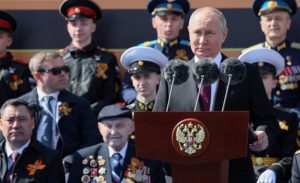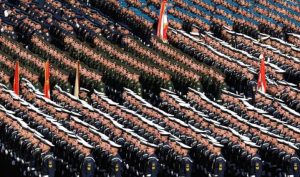PNN – Coinciding with the 80th anniversary of the end of World War II, Moscow is sending a clear message of resistance to the West and the continuation of the narrative of resistance in the Ukrainian war by holding a victory celebration in Red Square.
The ceremony commemorating the 80th anniversary of the end of World War II will be held in Moscow on Friday, May 9, 2025, in Red Square.
Victory Day is one of the most important events in the Russian political and military calendar, celebrated annually on May 9th to commemorate the defeat of Nazi Germany in World War II (1945). In addition to commemorating the historic victory of the Soviet Union, the event has also become a showcase of the military might of the Russian Federation. Over the past three years, this ceremony has gained special importance due to its coincidence with the war in Ukraine and has attracted the attention of many political and media circles around the world.
So, with Russia embroiled in a war with Ukraine and relations with the West at their lowest point in decades, this year’s ceremony is more symbolic and political than ever. Vladimir Putin is using the opportunity to reinforce the Kremlin’s historical narrative, portraying the ongoing war in Ukraine as a continuation of the fight against fascism.
Furthermore, the presence of elected leaders from Asia, Latin America, and Africa at the ceremony, alongside the absence of representatives from Western countries, clearly demonstrates the geopolitical divide in the current world order.
A show of power in Red Square; from the united units to the message of the allies
The official Victory Day ceremony will be held today, as in previous years, on Moscow’s Red Square. According to official reports, the ceremony will last about 2 hours and will include a speech by Putin, a minute of silence in memory of the victims of World War II, a parade of military units and a display of advanced military equipment. If weather conditions are favorable, the air part of the parade will also be held with fighter jets and helicopters flying over.

According to the Russian Defense Ministry, more than 14,000 soldiers will participate in the ceremony, and 210 pieces of military equipment, including armored vehicles, missile systems, and modern tanks, will be on display. Also, if weather conditions are favorable, the Russian Air Force will perform the air part of the parade with dozens of airplanes and helicopters, which is always one of the most impressive parts of the event.
Alongside Russian military units, units from 13 other countries will also participate in the ceremony. This international presence not only strengthens the official and international image of the celebration, but also sends a clear message of support or neutrality of these countries towards Russia in the war in Ukraine. The participation of foreign units, especially from countries that do not have close relations with the West, indicates Moscow’s continued efforts to build a front of political and strategic allies against the West.

The presence of foreign leaders is of particular importance at this ceremony. It is said that 29 leaders and high-ranking officials from different countries have accepted the invitation; Leaders of the Republic of Azerbaijan, Armenia, Belarus, Kazakhstan, Kyrgyzstan, Tajikistan, Turkmenistan, Uzbekistan, Abkhazia, Bosnia and Herzegovina, Brazil, Burkina Faso, Venezuela, Vietnam, Guinea-Bissau, Egypt, Zimbabwe, China, Congo, Cuba, Laos, Mongolia, Myanmar, Palestine, Serbia, Slovakia, Equatorial Guinea, Ethiopia, as well as the Republic of South Ossetia have traveled to Moscow for this purpose.
This is despite the fact that none of the leaders of European countries or the United States are present at the ceremony, which indicates the deep diplomatic gap between Russia and the West.
Ceremony held amid warnings: Moscow’s ironclad measures against Ukrainian disruption
In recent days, as the anniversary of the end of World War II approaches, the Russian government has implemented unprecedented security measures in Moscow. Thousands of security and military forces have been deployed throughout the capital, and the area around Red Square, the main venue for the ceremony, has been completely quarantined for several days. Restrictions have been imposed on the movement of the public, independent journalists, and even state media employees, and only invited media representatives are allowed to officially cover the ceremony.
Russia has also deployed air defense and anti-drone systems in several locations in and around Moscow. Defense systems such as the S-400 and Pantsir-S anti-drone systems are reportedly on alert 24/7 to thwart any potential air or drone attacks. Moscow’s international airports have also been temporarily closed for several hours ahead of the ceremony to prevent the passage of unidentified drones.
Overall, the Russian government has attempted to send a strong political message to the world by containing security threats and holding a grand ceremony with a large attendance of foreign dignitaries, amidst the Ukrainian war and international pressure.

Russia’s political message: Rebuilding the image of power in the midst of war
The grandiose May 9th celebrations in Moscow, amid a ravaging war with Ukraine and strained relations with the West, are a deliberate attempt by the Kremlin to redefine Russia’s political and military place in the global order. Putin and his political team are trying to use the symbolic capacity of Victory Day to portray the current war as a continuation of the historic struggle against fascism, thereby strengthening the political and moral legitimacy of Russia’s military actions.
The presence of leaders from countries such as China, Brazil, Venezuela, and a number of Asian and African countries in the complete absence of representatives from Western countries is a symbol of a new geopolitical alignment. This diplomatic arrangement sends a clear message that a multipolar world is emerging and that Russia, despite Western isolation, is still able to attract political and symbolic support from a segment of the international community.
The extensive security measures, media control, and effective response to the Ukrainian threats are all designed to project “stability in crisis.” By carefully managing this event, Russia intends to present an image of authority, cohesion, and capability to domestic and foreign audiences—an image that could challenge Russia’s weakened image in the Western media landscape.
Ultimately, this year’s May 9th ceremony is not just a historical reminder but a tool for global political narrative. By drawing on the symbols of World War II, the Kremlin seeks to establish its role in tomorrow’s world, a world in which the competition of powers is no longer simply military or economic, but also narrative and symbolic.

